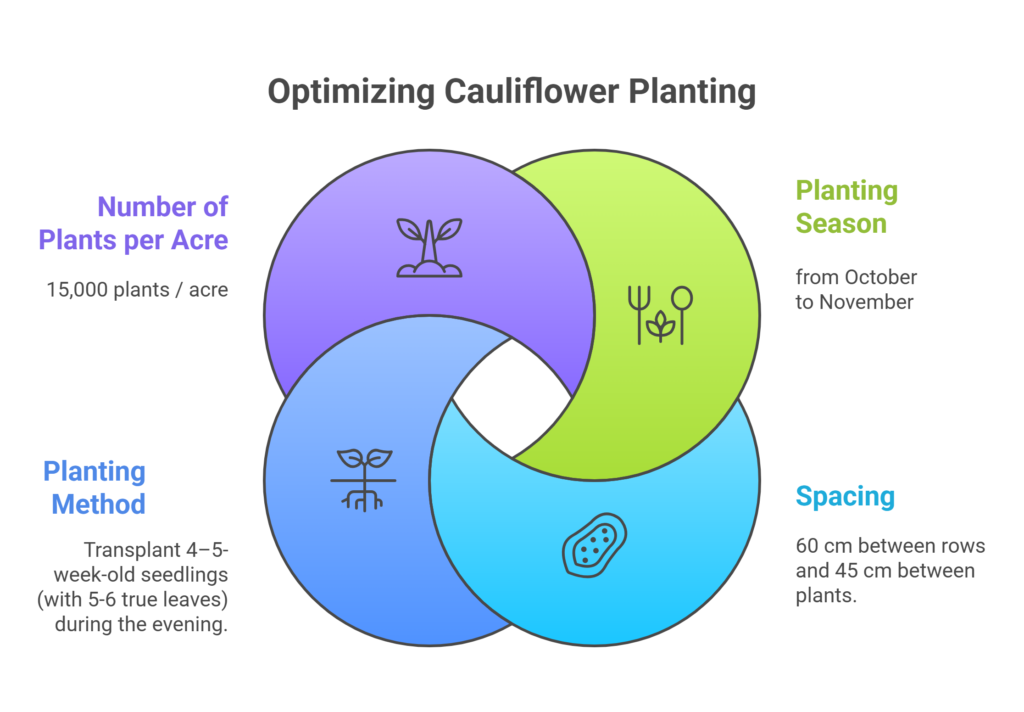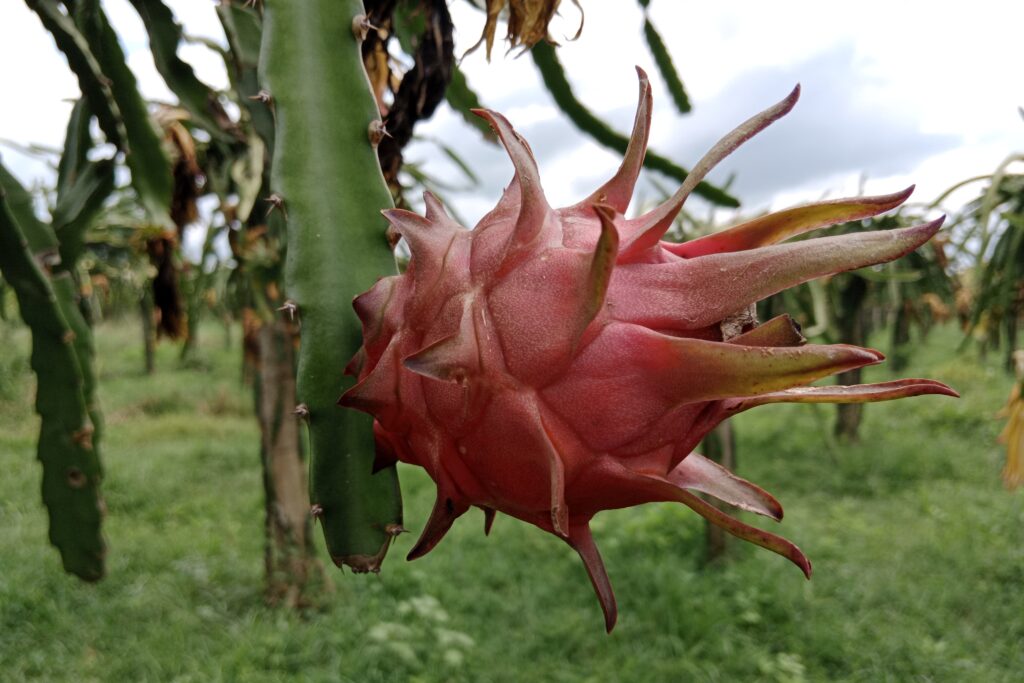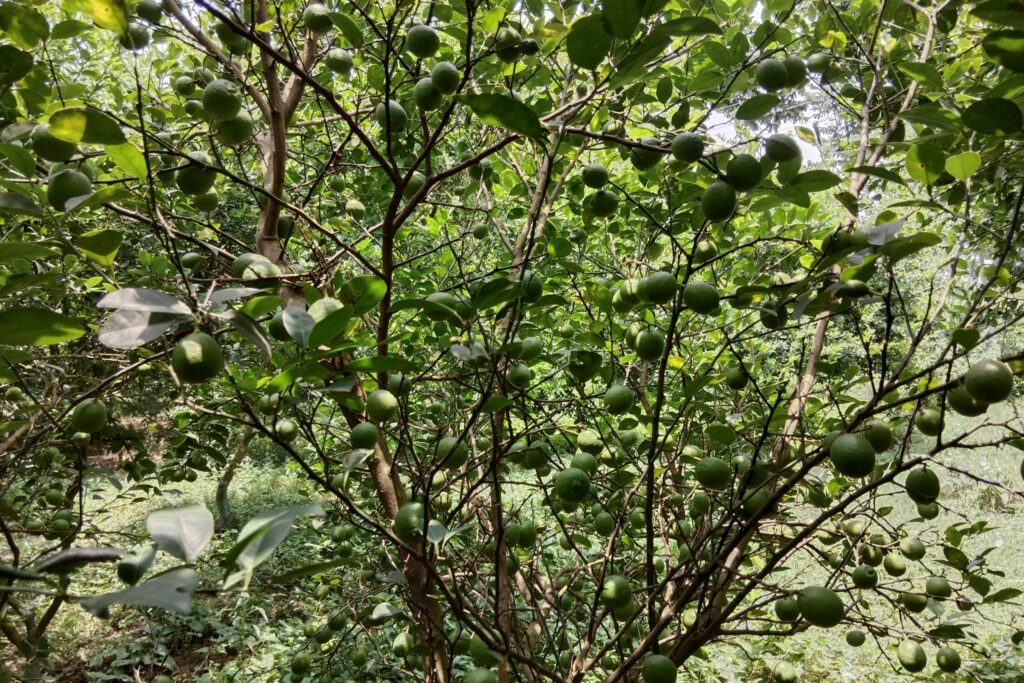Cauliflower Farming
Cauliflower farming profit per acre highlights its potential as an exceptionally lucrative agricultural endeavor, as demonstrated by detailed financial analysis. The total profit is calculated by subtracting the investment cost of NRs. 47,000 from the total income of NRs. 225,000, resulting in a net profit of NRs. 178,000. This impressive outcome yields a profit margin of approximately 378.7%, achieved by dividing the net profit by the total cost and multiplying by 100. These figures underscore the substantial return on investment (ROI) and confirm the financial viability of cauliflower farming under optimal conditions.

The profitability of cauliflower farming per acre is remarkably high, reflecting its potential as a lucrative agricultural pursuit. Based on financial calculations, a net profit of NRs. 178,000 is achieved from a total income of NRs. 225,000 after deducting the investment cost of NRs. 47,000. This impressive outcome yields a profit margin of approximately 378.7%, showcasing a significant return on investment. Such profitability highlights cauliflower farming as a promising venture for farmers under ideal yield and cost management conditions.
Land Preparation
Cauliflower thrives in well-drained, fertile soil, requiring thorough land preparation that begins with deep plowing (20-30 cm depth) followed by 2-3 harrowings to break down soil clods and ensure a fine tilth. To enhance soil structure and fertility, incorporate 20-25 tons of well-rotted farmyard manure (FYM) or compost per hectare (equivalent to 8-10 tons per acre) into the soil. Finally, level the field to prevent waterlogging, with raised beds or ridges recommended in areas prone to heavy rainfall to improve drainage and protect the crop.
Soil Type
Cauliflower thrives best in loamy or sandy loam soils rich in organic matter, with an optimal pH range of 6.0–6.5 for nutrient availability and root development; waterlogged or highly acidic soils should be avoided, as they hinder growth, and in cases where soil pH falls below 6.0, lime application is recommended to neutralize acidity and create a favorable growing environment.
Climatic Requirements
Cauliflower requires specific climatic conditions for optimal growth, thriving best in moderate temperatures between 15–20°C, as prolonged exposure to heat above 25°C leads to premature “buttoning” (formation of small, undersized curds), while frost or extreme cold can damage developing curds. Moderate humidity levels of 60–80% are ideal to support healthy growth, and consistent moisture is critical during the curd formation stage to prevent drought stress, which can result in stunted or cracked curds. Careful management of these factors ensures proper development, quality, and yield of the crop.
Major Cultivars
| Cultivar Type | Maturity Duration | Examples | Additional Notes |
| Early Season | 60–80 days | Snowball, Pusa Early Synthetic | Suitable for short growing periods. |
| Mid-Season | 90–120 days | Pusa Hybrid 2, Improved Japanese | Balances yield and adaptability. |
| Late Season | 120–150 days | Pusa Shukti, Dania | Ideal for extended growth cycles. |
| Regional Varieties | Varies | Punjab Giant-35 (India) | Adapted to local climate conditions. |
Seed Rate
For early-season varieties, use 500 gm of seed per acre, and for late or main-season varieties, use 250 gm per acre. Treat seeds by dipping them in hot water (50°C for 30 minutes) or a streptocycline solution (0.01 gm/L) for two hours, followed by shade drying before sowing. To prevent Blackrot in Rabi crops, treat seeds with a mercury chloride solution (1 gm/L) for 30 minutes and dry them. In sandy soil prone to stem rot, treat seeds with Carbendazim 50% WP (3 gm/kg). Proper treatment and drying promote healthier crop establishment under varying conditions.
Nursery Management
To prepare the nursery for cauliflower, create raised beds of 1-meter width and 15 cm height, mixing well-rotted FYM or compost with soil at a rate of 4 kg/m². After bed preparation, drench the soil with a fungicide solution (Captan or Thiram @2 g/L water) to prevent fungal infections. Sow seeds in rows spaced 8-10 cm apart, placing seeds 1.5-2 cm apart within rows at a depth of 1.5-2 cm, and cover them with a mixture of sand and FYM.
During the monsoon, protect the nursery under a polyhouse or polytunnel. Maintain beds by regularly irrigating as needed, performing weeding and intercultural operations, and ensuring proper drainage to promote healthy seedling growth. Seedlings are ready for transplanting within 4 to 5 weeks.
Planting

a). Planting Season
Cauliflower planting seasons vary depending on the climatic region. In temperate regions, the ideal planting times are during spring, from February to March, and in autumn, from August to September. In tropical regions, cauliflower is best planted in the winter months, specifically from October to November. Selecting the appropriate planting season for each climate zone ensures optimal growth conditions, such as suitable temperatures and day lengths, which are critical for successful crop development and high yields.
b). Spacing
In order to accommodate their higher growth and longer maturity period, late cultivars of cauliflower require a wider spacing of 60 cm between rows and 45 cm between plants, whereas early cultivars require a spacing of 45 cm between rows and 30 cm between plants. Plant health and efficient use of resources are guaranteed by proper spacing.
c). Planting Method:
For optimal establishment, transplant 4–5-week-old seedlings (with 5-6 true leaves) during the evening to minimize transplant shock, ensuring better acclimatization and survival rates in the field.
d). Number of Plants per Acre:
15,000 plants per acre based on the above spacing.
Irrigation
After transplanting, provide the first irrigation immediately to ensure proper root establishment. Subsequent irrigation intervals depend on soil type and climatic conditions, with watering every 7-8 days in summer and 10-15 days in winter. Key stages requiring careful irrigation include transplanting, curd initiation, and curd development. Light irrigation every 4-5 days in summer and every 7-10 days in winter is ideal. Drip irrigation is recommended for efficient water use and to minimize fungal risks, as it avoids overhead watering.
Fertilizer and Manure
| Category | Recommendation |
| Fertilizer Application | |
| Basal Dose | Apply 40 tonnes/acre of decomposed cow dung, 155 kg/acre Single Superphosphate (SSP), 40 kg/acre Muriate of Potash (MOP), and 55 kg/acre Urea (half of total) before transplanting. |
| Top Dressing | Apply remaining 55 kg/acre Urea 4 weeks after transplanting. |
| Foliar Spray | |
| Early Growth | Spray Water Soluble Fertilizer (19:19:19) @5-7 gm/Ltr water for better flower (curd) set and yield. |
| 40 Days after transplanting | Spray 12:61:00 @4-5 gm + micronutrients @2.5-3 gm + Boron @1 gm/Ltr water. |
| Curd Development | Apply Water Soluble Fertilizer (13:00:45) @8-10 gm/Ltr water to improve curd quality. |
| Micronutrient Management | |
| Magnesium Deficiency | Apply Magnesium Sulphate @5 gm/Ltr 30-35 days after transplanting (if soil test confirms deficiency). |
| Calcium Deficiency | Apply Calcium Nitrate @5 gm/Ltr 30-35 days after transplanting (if soil test confirms deficiency). |
| Deficiency Management | |
| Boron Deficiency | Symptoms: Hollow/discolored stems, brown curds, curled leaves. Apply Borax @250-400 gm/acre to address deficiency. |
Weed Control
| Method | Details |
| Manual | Hand weeding is required during the first 30–40 days after planting to control weed competition. |
| Mulching | Apply organic mulch (e.g., straw) to suppress weeds and retain soil moisture. |
| Herbicides | Use Pendimethalin herbicide at a rate of 1 liter per acre one day prior to transplanting seedlings to ensure effective pre-emergence weed control. |
Pest and Disease Management
Common Pests
a). Aphids/Cabbage Worms
Sucking pests like aphids and jassids extract sap from leaves, causing yellowing and drooping, while thrips lead to curling, cup-shaped leaves, or upward curving. To manage aphids and jassids, spray Imidacloprid 17.8 SL at 60 ml per acre using 150 liters of water. For thrips infestation, apply a spray of Triazophos + Deltamethrin at 20 ml or 25% Cypermethrin at 5 ml per 10 liters of water. Prompt pest management ensures healthier plant growth and prevents further damage.

b). Diamondback Moth
A major pest of cauliflower deposits eggs beneath leaf surfaces, producing greenish, hairy larvae that consume foliage, creating holes and risking 80–90% crop loss without intervention. Initial control involves spraying Neem Seed Kernel Extract (40 gm/L water) during head initiation, repeated every 10–15 days, while avoiding application at curd formation. Supplement with Bt formulations (200 gm/acre) at 35 and 50 days post-transplanting. For severe outbreaks, apply Spinosad 2.5% SC (80 ml/150 L water) to curb infestation and safeguard yield. Timely, targeted management ensures minimal damage and optimal crop health.
c). Caterpillar
Spodoptera larvae, which damage crops by feeding on leaves, often infest fields post-rainfall. If two caterpillars per crop are detected, apply Bacillus thuringiensis (B.T.) at 10 gm/10 Ltr water during evening hours, followed by neem ark spray (40 gm/Ltr). For severe infestations, use Thiodicarb 75WP (40 gm/15 Ltr water). In cases of leaf-eating caterpillar outbreaks, opt for Spinosad 2.5%EC (60 ml/acre) or Emamectin Benzoate 5SG (100 gm/acre) mixed in 150 Ltr water. Timely application and adherence to dosage ensure effective pest control and crop protection.
Common Diseases
a). Alternaria leaf spot:
To manage disease effectively, remove and burn lower leaves in the morning to reduce infection sources. Follow this by spraying Tebuconazole 50% + Trifloxystrobin 25% at 120 gm per acre, or use Mancozeb at 2 gm per liter of water or Carbendazim at 1 gm per liter of water, ensuring proper coverage for effective control.
b). Downy Mildew
Purplish-brown spots with greyish-white mold often appear on the underside of leaves when downy mildew infects crops. Maintaining proper sanitation and practicing crop rotation can significantly reduce the risk of infection. If downy mildew is detected, control it by spraying a mixture of Metalaxyl and Mancozeb at 2 gm per liter of water, applied three times at 10-day intervals.
c). Clubroot
Clubroot, a soil-borne disease affecting cruciferous crops, can be effectively managed by maintaining a soil pH above 6.5, as the pathogen thrives in acidic conditions. Liming acidic soils to increase pH creates an unfavorable environment for the disease. Additionally, practicing crop rotation with non-host crops helps break the pathogen’s life cycle, reducing its persistence in the soil. These measures collectively minimize the risk of clubroot infection and promote healthier crop growth.
d). Leaf spot and Blight
To manage blight infestation, spray Mancozeb or Copper Oxychloride at 300 gm per 150 liters of water, adding 20 ml of a sticker to enhance adherence and effectiveness.
Harvesting
In order to avoid “riciness” (loose, over-mature curds), cauliflower should be harvested when the curds are solid, compact, and reach a marketable size of 15-20 cm diameter. To protect the curds during handling and transportation, cut them with a sharp knife while keeping the five to six wrapper leaves. Yields, which vary depending on cultivar and management effectiveness, normally fall between 15 and 20 tons per acre under ideal cultivation conditions. Curds should be stored at 0–4°C and 90–95% humidity after harvest in order to preserve freshness and increase shelf life by three to four weeks. Quality and market value are guaranteed by timely harvesting and appropriate methods.
Cost of Production of Cauliflower per Acre
| S.N. | Categories | Cost for Local Variety (NRs.) |
| 1 | Land Preparation (plowing, leveling) | 15,000 |
| 2 | Seed rate per acre | 2,000 |
| 3 | Labor Costs (transplanting) | 3,000 |
| 4 | Fertilizers and Manure | 8,000 |
| 5 | Irrigation | 5,000 |
| 6 | Weed Control | 2,000 |
| 7 | Pest & Disease Control | 5,000 |
| 8 | Harvesting | 2,000 |
| 9 | Miscellaneous Costs | 5,000 |
| Total Cost | 47,000 |
Income from Per Acre Cauliflower Farming
| Particulars | Estimated Yield/Acre (kg) | Market Price (NRs/kg) | Total Income (NRs.) |
| Cauliflower Yield | 15,000 | 15 | 225,000 |
Analysis of Cauliflower Farming Profit Per Acre
a). Total Profit Calculation
The total income generated from one acre of cauliflower farming is NRs. 225,000, while the total investment cost amounts to NRs. 47,000. Subtracting the total cost from the income gives a net profit of NRs. 178,000 (225,000 − 47,000).
b). Profit Margin
The profit margin is calculated by dividing the net profit by the total investment and converting it to a percentage. With a net profit of NRs. 178,000 and total costs of NRs. 47,000, the profit margin is approximately 378.7% [(178,000 ÷ 47,000) × 100]. This exceptionally high margin highlights the strong return on investment (ROI) achievable in cauliflower farming under the given conditions.


